Birds of Kabini, 14 and 150511
May 24, 2011
This trip to Kabini was a real bonanza in terms of birds; we sighted a 103 or 104 species of birds in the two days that we were there, and also got to observe a lot, rather than just looking and passing on.
As we drove towards Mysore, we decided to take a little detour through Ranganathittu, not going towards the boating area but towards the old quarry. And of course, we immediately struck a jackpot with several
BLUE-TAILED BEE-EATERS
flying around. One came in, obligingly, with a Cicada in its mouth, and posed for us:
 We saw several
INDIAN GREY HORNBILLS
around, and one on the tree had just found a fig for breakfast:
We saw several
INDIAN GREY HORNBILLS
around, and one on the tree had just found a fig for breakfast:
 The deep pit in the quarry area had a lot of reeds, and of course, reeds mean Weaver birds; in this case, some
STREAKED WEAVERS:
The deep pit in the quarry area had a lot of reeds, and of course, reeds mean Weaver birds; in this case, some
STREAKED WEAVERS:
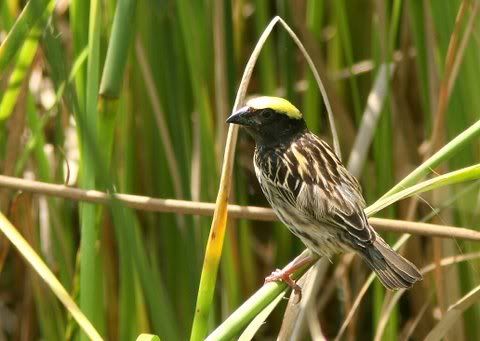 (their triumph of home architecture is on my Facebook album, the link is at the end.)
A wire on the wire...several
WIRE-TAILED SWALLOWS
sat up on the telephone lines, and I caught one:
(their triumph of home architecture is on my Facebook album, the link is at the end.)
A wire on the wire...several
WIRE-TAILED SWALLOWS
sat up on the telephone lines, and I caught one:
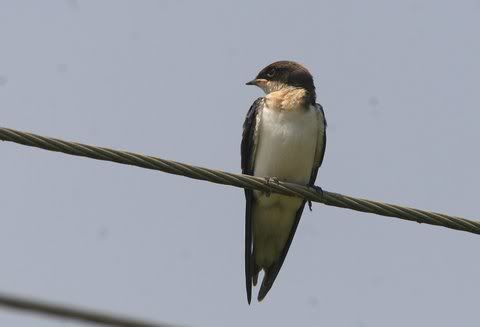 As we went further, we stopped as we suddenly spotted some
ALPINE SWIFTS
which were a lifer for me. It was very difficult, indeed, to catch one of these in flight, so there will be no snide remarks about fuzzy photos...one of my usual SMS (Shamelessly Mediocre Shots)!
As we went further, we stopped as we suddenly spotted some
ALPINE SWIFTS
which were a lifer for me. It was very difficult, indeed, to catch one of these in flight, so there will be no snide remarks about fuzzy photos...one of my usual SMS (Shamelessly Mediocre Shots)!
 In the fields, of course,
BLACK IBIS
were walking around feeding on the insects:
In the fields, of course,
BLACK IBIS
were walking around feeding on the insects:
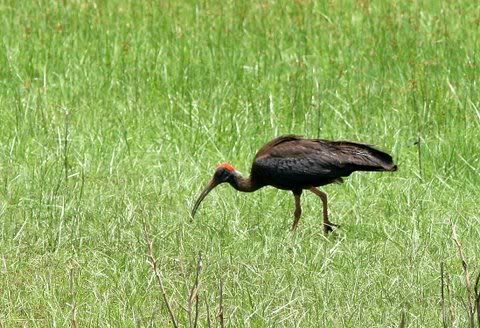 A sight that truly lifted our hearts (like that of the poet Wordsworth!) was the one of several
CRESTED LARKS
on the ground, or the wires, singing:
A sight that truly lifted our hearts (like that of the poet Wordsworth!) was the one of several
CRESTED LARKS
on the ground, or the wires, singing:
 Gopal's car had stopped, unable to move past this
BLACK-WINGED KITE:
Gopal's car had stopped, unable to move past this
BLACK-WINGED KITE:
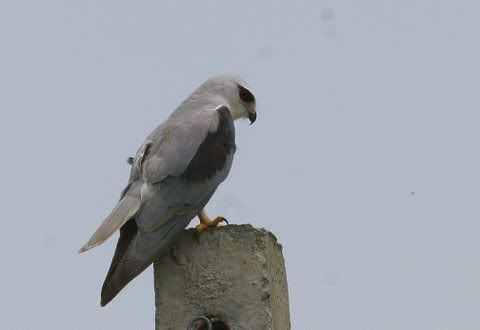 Now that's my favourite "urban" raptor, so we too ogled it for a while and then we moved on.
As we prepared to join the JLR (Kabini River Lodge) safari in the evening, we first heard, and then caught sight of, this
COPPERSMITH BARBET:
Now that's my favourite "urban" raptor, so we too ogled it for a while and then we moved on.
As we prepared to join the JLR (Kabini River Lodge) safari in the evening, we first heard, and then caught sight of, this
COPPERSMITH BARBET:
 It might be a very common bird, but it certainly is very beautiful!
In the gardens, several
HOUSE SPARROWS
reassured us that sparrows are, indeed, back amongst us. Here's a male, helping with nesting material:
It might be a very common bird, but it certainly is very beautiful!
In the gardens, several
HOUSE SPARROWS
reassured us that sparrows are, indeed, back amongst us. Here's a male, helping with nesting material:
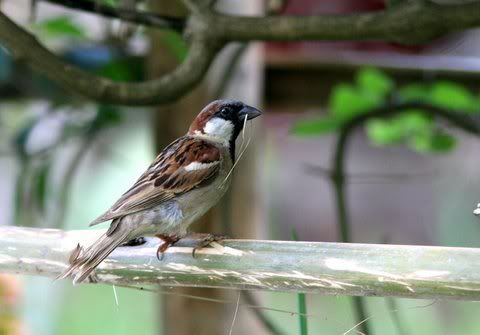 Here's a female, ready to fly off to her nest under the eaves:
Here's a female, ready to fly off to her nest under the eaves:
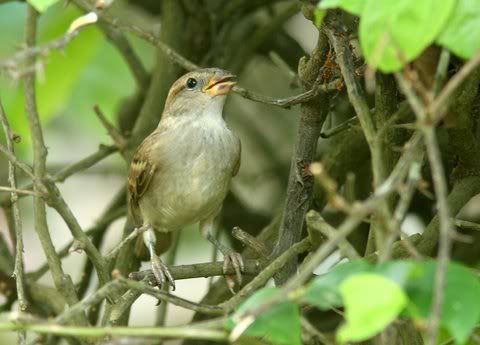 The next morning's safari started, for us, just outside the JLR gates...in the most eventful way. A mother
BARRED BUTTONQUAIL
and her three babies decided, suddenly, to cross the road just as our jeep went past...we screeched to a halt, and the jeep went right over them. We looked back in horror...and found that since the three babies had "frozen" to the ground at the first sign of a threat, they were fine, and that the mother was still under our jeep, looking for them! Here's one of them....just look at that little clump of feathers and that eye...have you even seen anything more defenceless?
The next morning's safari started, for us, just outside the JLR gates...in the most eventful way. A mother
BARRED BUTTONQUAIL
and her three babies decided, suddenly, to cross the road just as our jeep went past...we screeched to a halt, and the jeep went right over them. We looked back in horror...and found that since the three babies had "frozen" to the ground at the first sign of a threat, they were fine, and that the mother was still under our jeep, looking for them! Here's one of them....just look at that little clump of feathers and that eye...have you even seen anything more defenceless?
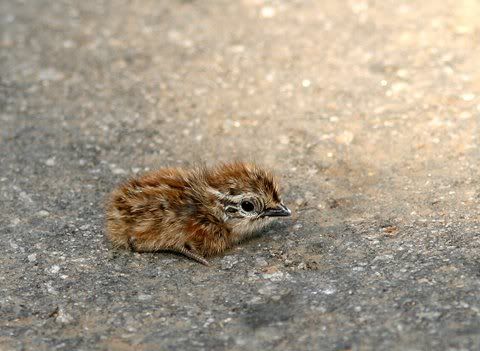 We had to stop three more jeeps coming out on to the road, and everyone was wondering what the fuss was about! Sometimes tiny problems can be large one...
Here's another one...would you believe that this little scrap is actually a living creature?
We had to stop three more jeeps coming out on to the road, and everyone was wondering what the fuss was about! Sometimes tiny problems can be large one...
Here's another one...would you believe that this little scrap is actually a living creature?
 Prasanna, our naturalist from JLR, scooped them up carefully on a small piece of paper and deposited them carefully at the side on the road, where they quickly clambered off into the foliage. The mother followed...and heaving a sigh of relief, we carried on, too. These birds...did make us quail for a while!
On the path, every safari, we saw this beautiful
BLUE-BEARDED BEE-EATER
on the tree:
Prasanna, our naturalist from JLR, scooped them up carefully on a small piece of paper and deposited them carefully at the side on the road, where they quickly clambered off into the foliage. The mother followed...and heaving a sigh of relief, we carried on, too. These birds...did make us quail for a while!
On the path, every safari, we saw this beautiful
BLUE-BEARDED BEE-EATER
on the tree:
 and here, the beard is showing:
and here, the beard is showing:
 I have never before seen so many peacocks dancing...and two at a time, too! Far ahead on the jungle path, were these two dancers, practising for some unknown female, but certainly enchanting us.
First they both faced the other way:
I have never before seen so many peacocks dancing...and two at a time, too! Far ahead on the jungle path, were these two dancers, practising for some unknown female, but certainly enchanting us.
First they both faced the other way:
 and then one faced us:
and then one faced us:
 Here's the beauty of one of them, who came closer and started preening himself:
Here's the beauty of one of them, who came closer and started preening himself:
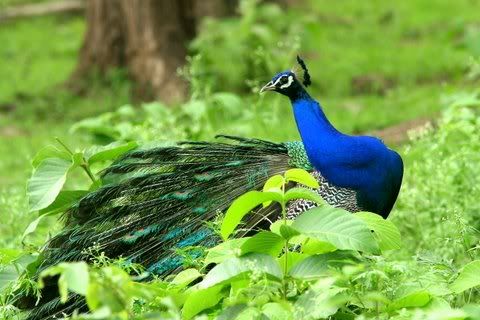 The peacock flew up to the tree-stump too close for my lens focal length, so I had to use a diagonal shot to get his full flauntiness!
The peacock flew up to the tree-stump too close for my lens focal length, so I had to use a diagonal shot to get his full flauntiness!
 The next morning, we took a boat safari on the backwaters of the Kabini, and saw a multitude of birds, including these
OPENBILL STORKS:
The next morning, we took a boat safari on the backwaters of the Kabini, and saw a multitude of birds, including these
OPENBILL STORKS:
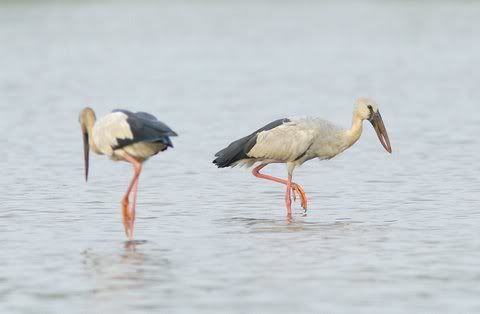 some
PURPLE HERONS:
some
PURPLE HERONS:
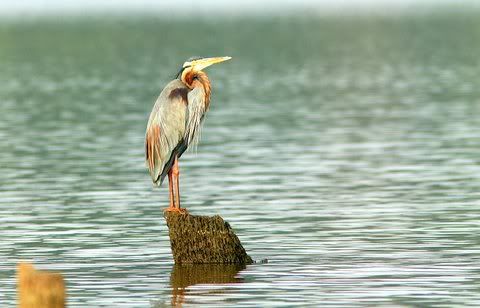 some
ASHY WOODSWALLOWS
swooped and landed, reminding me of the many I'd seen in Thattekkad, in Kerala:
some
ASHY WOODSWALLOWS
swooped and landed, reminding me of the many I'd seen in Thattekkad, in Kerala:
 On the banks, another unusual sight was several
GREY JUNGLEFOWL,
all together; I've always seen only one at a time, before this.
On the banks, another unusual sight was several
GREY JUNGLEFOWL,
all together; I've always seen only one at a time, before this.
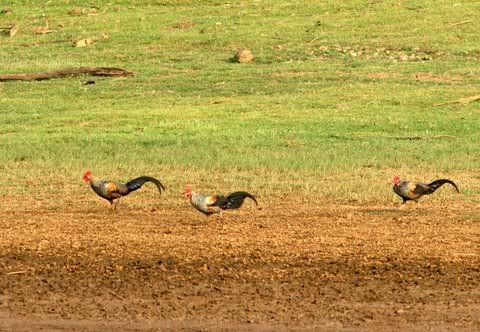 On the water were the fishermen, sorry, fisherbirds, that included this
GREATER CORMORANT:
On the water were the fishermen, sorry, fisherbirds, that included this
GREATER CORMORANT:
 it was lovely to watch the
PAINTED STORKS
fish...they hold their wings up over the water so that the fish cannot see the sharp beak of death shooting through the air, lethally!
it was lovely to watch the
PAINTED STORKS
fish...they hold their wings up over the water so that the fish cannot see the sharp beak of death shooting through the air, lethally!
 Another able angler is the
ORIENTAL DARTER,
which is also called the
SNAKE-BIRD
because of the shape of its neck, suited to gulping down wriggly eels!
Another able angler is the
ORIENTAL DARTER,
which is also called the
SNAKE-BIRD
because of the shape of its neck, suited to gulping down wriggly eels!
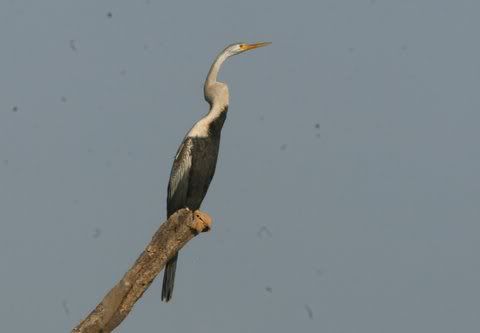 Of course another fisher is the
WHITE-BREASTED KINGFISHER
shown here in successful pursuit of breakfast!
Of course another fisher is the
WHITE-BREASTED KINGFISHER
shown here in successful pursuit of breakfast!
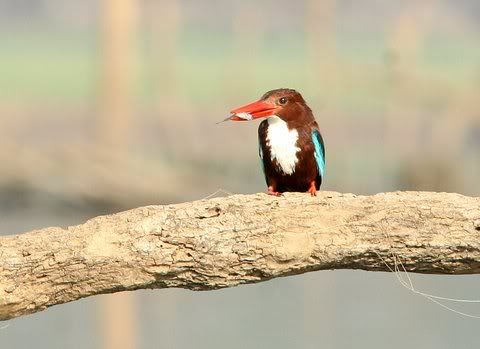 a
GREAT EGRET
waded about, in similar pursuit:
a
GREAT EGRET
waded about, in similar pursuit:
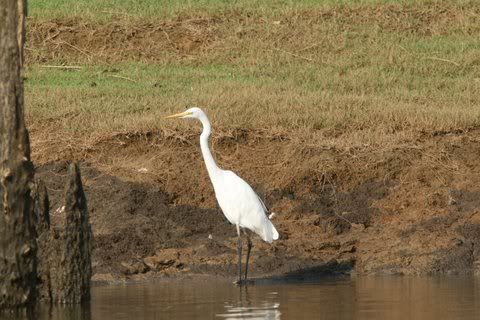 and a beautiful
SPOT-BILLED DUCK
was waiting for his turn...
and a beautiful
SPOT-BILLED DUCK
was waiting for his turn...
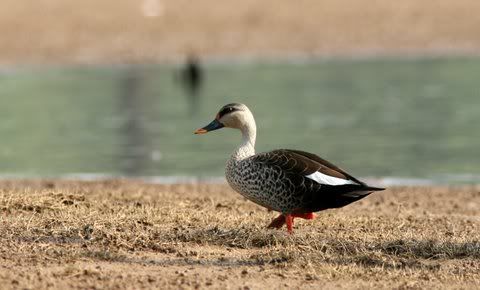 talking about turns, here is a
RIVER TERN...
talking about turns, here is a
RIVER TERN...
 a mother
LONG-TAILED SHRIKE
brought "six-legged breakfast" for that very demanding young one next to her, and then went on repeated sorties for more food:
a mother
LONG-TAILED SHRIKE
brought "six-legged breakfast" for that very demanding young one next to her, and then went on repeated sorties for more food:
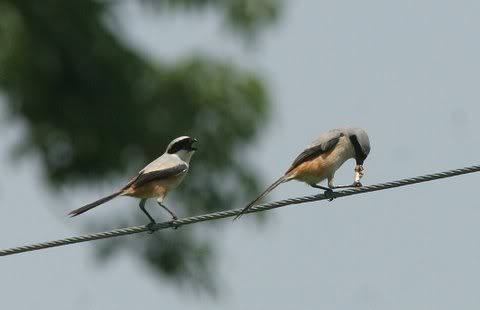 We were prevented from bemoaning the lack of raptors because this
CRESTED SERPENT EAGLE
appeared to pose:
We were prevented from bemoaning the lack of raptors because this
CRESTED SERPENT EAGLE
appeared to pose:
 Late in the evening, on a "This property belongs to R Raman" board (the "this" is visible!)...an
ORIENTAL MAGPIE ROBIN
couple sat:
Late in the evening, on a "This property belongs to R Raman" board (the "this" is visible!)...an
ORIENTAL MAGPIE ROBIN
couple sat:
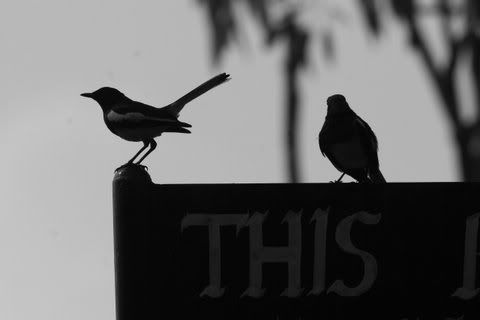 A few final sightings included this beautiful
HOOPOE:
A few final sightings included this beautiful
HOOPOE:
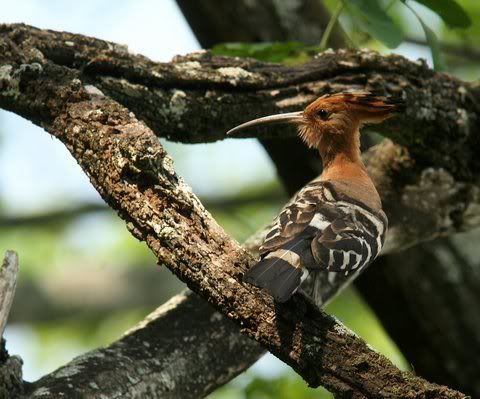 and as we were leaving Water Woods, the extremely expensive resort where we stayed, we watched for a while, and saw this baby
WHITE-CHEEKED BARBET
snug in its nest, peeping out curiously, and fearlessly!
and as we were leaving Water Woods, the extremely expensive resort where we stayed, we watched for a while, and saw this baby
WHITE-CHEEKED BARBET
snug in its nest, peeping out curiously, and fearlessly!
 Here's the bird, mammals and others list:
Babbler, Jungle
Barbet, Coppersmith
Barbet, White-cheeked
Bee- Eater,Blue-bearded
Bee-Eater, Blue-tailed
Bee-Eater, Small Green
Bulbul, Red-vented
Bulbul, Red-whiskered
Bushchat, Pied
Buttonquail, Barred
Buzzard, Oriental Honey
Cisticola, Zitting
Cormorant, Greater
Cormorant, Little
Coucal. Greater
Crow, House
Crow, Jungle
Cuckoo, Common Hawk
Cuckoo, Indian
Cuckoo.Pied
Duck, Spot-billed
Drongo, Ashy
Drongo, Black
Drongo, Bronzed
Drongo, Greater Racket-tailed
Drongo, White-bellied
Darter, Oriental
Dove, Spotted
Egret, Cattle
Egret, Great
Egret, Little
Egret, Intermediate
Flycatcher, White browed Fantail
Eagle, Crested Serpent
Francolin, Grey
Flameback, Greater
Flowerpecker, Pale-billed
Heron, Pond
Heron, Grey
Heron, Purple
Hoopoe, Common
Hornbill, Indian Grey
Hornbill, Malbar Pied
Ibis, Black-headed
Ibis, Black
Iora, Common
Junglefowl, Grey
Kingfisher, Common
Kingfisher, Stork-billed
Kingfisher, White-breasted
Kite, Black
Kite, Black-winged
Kite, Brahminy
Koel, Asian
Lapwing, Red-wattled
Lark, Crested
Minivet, Small
Munia, Black-headed
Munia, Scaly-breasted
Munia, White-rumped
Mynah, Common
Myna, Jungle
Myna, Hill
Openbill, Asian
Parakeet, Rose-ringed
Parakeet, Plum-headed
Parakeet, Malabar
Parrot, Vernal Hanging
Peafowl, Indian
Pelican, Spot-billed
Pigeon, Blue Rock
Plover, Little Ringed
Praticole, Small
Prinia, Ashy
Prinia, Jungle
Prinia, Plain
Robin, Indian
Robin, Oriental Magpie
Roller, Indian
Shrike, Long-tailed
Spoonbill, Eurasian
Sparrow, House
Starling, Brahminy
Stilt, Black-winged
Stork, Painted
Stork, Woolly-necked
Sunbird, Purple-rumpled
Swallow, Red-rumped
Swallow, Wire-tailed
Swift, Alpine
Swift, Palm
Tailorbird, Common
Tern, River
Treepie, Rufous
Trogon, Malabar
Vulture, Egyptian
Wagtail, Pied
Warbler, Blyth's Reed
Warblers, un id
Waterhen, White-breasted
Weaver, Streaked
Whistling-duck, Lesser
White-eye, Oriental
Woodswallow, Ashy
Mammals
Boar, Wild
Chital
Elephant, Asian
Gaur
Langur, Black-faced
Leopard
Macaque, Bonnet
Otter, Smooth-coated
Sambar
Squirrel, Malabar Giant
Reptiles and Amphibians
Bullfrog, Indian
Crocodile
Keelback, Chequered
Frog, Bicolored
Frog, Skittering
Skink, Red-tailed
Butterflies
Brown, Evening
Bush Brown, Common
Castor, Angled
Emigrant, Common
Emigrant, Lime
Gull, Common
Jezebel, Common
Leopard, Common
Lime, Common
Psyche
Rose, Common
Rose, Crimson
Tiger, Common
Yellow, Common Grass
Yellow, Spotless Grass
Un id Jumping, Orb and Lynx Spiders, and Dragonflies. Damselflies, Ants, Millipedes, Stick Insect
Here's the bird, mammals and others list:
Babbler, Jungle
Barbet, Coppersmith
Barbet, White-cheeked
Bee- Eater,Blue-bearded
Bee-Eater, Blue-tailed
Bee-Eater, Small Green
Bulbul, Red-vented
Bulbul, Red-whiskered
Bushchat, Pied
Buttonquail, Barred
Buzzard, Oriental Honey
Cisticola, Zitting
Cormorant, Greater
Cormorant, Little
Coucal. Greater
Crow, House
Crow, Jungle
Cuckoo, Common Hawk
Cuckoo, Indian
Cuckoo.Pied
Duck, Spot-billed
Drongo, Ashy
Drongo, Black
Drongo, Bronzed
Drongo, Greater Racket-tailed
Drongo, White-bellied
Darter, Oriental
Dove, Spotted
Egret, Cattle
Egret, Great
Egret, Little
Egret, Intermediate
Flycatcher, White browed Fantail
Eagle, Crested Serpent
Francolin, Grey
Flameback, Greater
Flowerpecker, Pale-billed
Heron, Pond
Heron, Grey
Heron, Purple
Hoopoe, Common
Hornbill, Indian Grey
Hornbill, Malbar Pied
Ibis, Black-headed
Ibis, Black
Iora, Common
Junglefowl, Grey
Kingfisher, Common
Kingfisher, Stork-billed
Kingfisher, White-breasted
Kite, Black
Kite, Black-winged
Kite, Brahminy
Koel, Asian
Lapwing, Red-wattled
Lark, Crested
Minivet, Small
Munia, Black-headed
Munia, Scaly-breasted
Munia, White-rumped
Mynah, Common
Myna, Jungle
Myna, Hill
Openbill, Asian
Parakeet, Rose-ringed
Parakeet, Plum-headed
Parakeet, Malabar
Parrot, Vernal Hanging
Peafowl, Indian
Pelican, Spot-billed
Pigeon, Blue Rock
Plover, Little Ringed
Praticole, Small
Prinia, Ashy
Prinia, Jungle
Prinia, Plain
Robin, Indian
Robin, Oriental Magpie
Roller, Indian
Shrike, Long-tailed
Spoonbill, Eurasian
Sparrow, House
Starling, Brahminy
Stilt, Black-winged
Stork, Painted
Stork, Woolly-necked
Sunbird, Purple-rumpled
Swallow, Red-rumped
Swallow, Wire-tailed
Swift, Alpine
Swift, Palm
Tailorbird, Common
Tern, River
Treepie, Rufous
Trogon, Malabar
Vulture, Egyptian
Wagtail, Pied
Warbler, Blyth's Reed
Warblers, un id
Waterhen, White-breasted
Weaver, Streaked
Whistling-duck, Lesser
White-eye, Oriental
Woodswallow, Ashy
Mammals
Boar, Wild
Chital
Elephant, Asian
Gaur
Langur, Black-faced
Leopard
Macaque, Bonnet
Otter, Smooth-coated
Sambar
Squirrel, Malabar Giant
Reptiles and Amphibians
Bullfrog, Indian
Crocodile
Keelback, Chequered
Frog, Bicolored
Frog, Skittering
Skink, Red-tailed
Butterflies
Brown, Evening
Bush Brown, Common
Castor, Angled
Emigrant, Common
Emigrant, Lime
Gull, Common
Jezebel, Common
Leopard, Common
Lime, Common
Psyche
Rose, Common
Rose, Crimson
Tiger, Common
Yellow, Common Grass
Yellow, Spotless Grass
Un id Jumping, Orb and Lynx Spiders, and Dragonflies. Damselflies, Ants, Millipedes, Stick Insect
and finally, here’s the State Bird of Karnataka (or as someone put it, the “National Bird of Karnataka”!)
More detailed photographs on my Facebook album,


